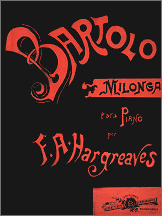By
Bartolo - Francisco A. Hargreaves and the true story of the tango “Bartolo”

e was son of a hardware dealer —perhaps the first who established a hardware store in Buenos Aires—, and he had certain North American ancestors. Only a few approached the creole lore with so much musical sensitivity and knowledge.
He was born in Buenos Aires, on December 31, 1849 (in the middle of Rosas s time) and died, still young, when he was 51 years old, on December 30, 1900. He, then, did not reach the XX century.
 He is considered the first Argentine who premiered an opera, La gatta bianca, a curious toy nearly surrealist in which a young man falls in love with a female cat and, to make him come to reason, he is placed before a woman dressed in white who, to stick to the role, even mews.
He is considered the first Argentine who premiered an opera, La gatta bianca, a curious toy nearly surrealist in which a young man falls in love with a female cat and, to make him come to reason, he is placed before a woman dressed in white who, to stick to the role, even mews.
Hargreaves had a solid musical instruction in Florence, as disciple of the maestro Maglioli. But his folk and native work is what interests us.
In 1874 he published “El pampero”, polka for piano, for four hands. His “Aires Nacionales” comprise gato, vidalita, décima, estilo and cielito. He developed correct «caprices» of gato, but without depriving the genre of its folk air.
He is regarded as the author of the tango “Bartolo”, but he only is —and he did not intended a different thing— who committed to piano sheet music a work surely anonymous, popularized, even, in different countries of America. The picaresque local lyric says:
Bartolo tenía una flauta
con un aujerito solo
y su madre le decía:
tocá la flauta, Bartolo.
Bartolo had a pretty flute
with an only little hole, oh!
and his mother used to tell him:
Please, play the flute, dear Bartolo.
This composition, in three sections, was published in its first issue (which was ours and fell through, borrowed by the magazine Que) in 1900, shortly before his death.
Long time ago, don Elías Martínez Buteler gave us a revealing version about “Bartolo”'s origin. He told us that his grandmother had seen how, on an island of Tigre, Hargreaves —who had arrived at the place with a small chamber orchestra put together with friends— sent for some black guitar players who were interpreting “Bartolo” near that summer place and transcribed, with an expert music notation, the bars of the famous tango.
The milongas by Francisco Hargreaves deserve a special attention. I lent two of them —those titled “Tercera milonga” and “Hay de mí”— to the distinguished musician Alberto Ginastera who played them in a concert, excelling with the novelty. It costed me some effort to recover them.
 Hargreaves is also composer of “La rubia”, a nice habanera that the maestro Sebastián Piana made us hear on piano.
Hargreaves is also composer of “La rubia”, a nice habanera that the maestro Sebastián Piana made us hear on piano.
The writer and musician C. Saúl Villar had written an interesting study about Hargreaves, which we think has remained unpublished. To search after that work could be an important contribution to update Hargreaves much estimated credits, and his pioneering involvement in our tradicional music, translated to piano with faultless skill, keeping the primitive creole taste.
In a juvenile photograph we can see Hargreaves as a slim person, with high forehead and curly hair. Tradicional news tell us that he was a man of pleasant company, witty, plenty of amusing well-timed jokes, a good chess player and he had a little voice in falsetto, which soon was forgotten by means of his sharp witty remarks.
Originally published in the magazine Desmemoria #6, Buenos Aires.